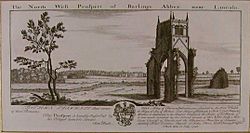Barlings Abbey facts for kids

Barlings Abbey, engraving by Samuel Buck
|
|
| Monastery information | |
|---|---|
| Order | Premonstratensian |
| Established | 1154 |
| Disestablished | 1537 |
| Mother house | St Mary and St. Martial at Newsham |
| Dedicated to | Assumption of the Blessed Mary |
| People | |
| Founder(s) | Ralph de Haye |
Barlings Abbey was once a large and important monastery in Lincolnshire, England. It was founded in 1154 by a group of monks called the Premonstratensians. This order of monks was known for living a strict life and often settling in quiet, rural areas. Barlings Abbey was a "daughter house" of another monastery, the Abbey of St. Mary and St. Martial in Newsham.
A Look Back: History of Barlings Abbey
Barlings Abbey was started by a man named Ralph de Haye. He was the son of an important official at Lincoln Castle. The abbey was first built at a place called Barlings Grange. But it soon moved to its current location, which was then known as Oxeney.
Later, a noblewoman named Maud, who was the wife of William Longespee, helped the abbey. She gave them land in Caenby. This gift helped support more monks, adding four to the original thirteen.
During the Middle Ages, the area of Lincolnshire had many people living in it. It was home to nine different Premonstratensian monasteries. Besides Barlings Abbey, there were places like Cammeringham Priory and Newsham Abbey.
Around the mid-1300s, the monks at Barlings Abbey faced tough times. They had serious money problems and were in debt. Even by 1412, when there were twenty-seven monks living there, it was hard to support them all because of the abbey's poverty. However, things got better by 1497. The abbot (the head monk) was praised for managing the abbey well, and the monastery was in good shape.
The Abbey's End: Dissolution
The abbey's story took a dramatic turn during the Dissolution of the monasteries. This was a time in the 1530s when King Henry VIII decided to close down many monasteries across England.
Barlings Abbey became involved in protests against these closures. The abbot, Matthew Mackarel, was thought to be one of the leaders of a protest movement in Lincolnshire. Because of this, he and six other monks from Barlings Abbey were executed.
The king used the abbot's actions as a reason to take over Barlings Abbey. The abbey was officially closed, and the remaining monks were sent away. They received very little money or help because of what their fellow monks had done. The abbey church was badly damaged. Its lead roof was torn off and melted down under the orders of King Henry VIII's chief minister, Thomas Cromwell. The abbey's land and buildings then became the property of the Duke of Suffolk.
After the Closure: What Remains
After the abbey closed, parts of its buildings, like the cloister (a covered walkway), stood until 1730. The tall central tower of the church also remained for a long time, finally collapsing in 1757. We know what it looked like thanks to an old drawing made by Samuel Buck in 1726.
Today, not much of Barlings Abbey is left. You can see some earthworks (changes in the ground where buildings once stood) and one large piece of the nave wall (part of the main church building). These are open for people to visit.
There was also a main building outside the church. Experts believe this might have been where the abbot lived. After the abbey closed, this building was changed into a home for Charles Brandon, 1st Duke of Suffolk. He was a very important person, acting as King Henry VIII's representative in Lincolnshire after the local protests.


